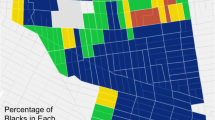Abstract
The relocation and consolidation of subarctic native populations into settlement patterns designed according to southern, urban models has often resulted in cultural confusion and an increase in interpersonal tension, alcohol abuse, and violence. Through a review of selected case material, and the detailed examination of one relocated community, the dynamics of this situation are highlighted. Where native communities have re-established themselves beyond the reach of government planners, the recreation of more culturally appropriate settlement patterns has ensued.
Similar content being viewed by others
References
Acheson, A. W. (1981). Old Crow, Yukon. In Helm, J. (ed.),Handbook of North American Indians (Vol. 6), Subarctic. Smithsonian, Washington, pp. 694–703.
Brokensha, D. and Scudder, T. (1968). Resettlement. In Rubin, N., and Warren, W. (eds.),Dams in Africa. A. M. Kelly, New York, pp. 20–62.
Chambers, R. (1970).The Volta Resettlement Experience. Praeger, New York.
Colson, E. (1971).The Social Consequences of Resettlement: The Impact of the Kariba Resettlement upon the Gwembe Tonga. Manchester University Press, Manchester.
Dickman, P. (1969). Thoughts on relocation.Musk-Ox 6: 21–31.
Dickman, P. (1973). Spatial change and relocation. In Rogge, J. (ed.),Developing the Subarctic. University of Manitoba, Winnipeg, pp. 145–174.
Driben, P., & Trudeau, R. S. (1983).When Freedom is Lost: The Dark Side of the Relationship between Government and the Fort Hope Band. University of Toronto Press, Toronto.
Erikson, K. T., and Vecsey, C. (1980). A report to the people of Grassy Narrows. In Vecsey, C., and Venables, R. (eds.),American Indian Environments. Syracuse University Press, Syracuse, pp. 152–161.
Hanson, A., and Oliver-Smith, A. (eds.). (1982).Involuntary Migration and Resettlement: The Problems and Responses of Dislocated People. Westview, Boulder, Colorado.
Helm, J. (1961).The Lynx Point People: The Dynamics of a Northern Athapaskan Band. National Museum of Canada Bulletin No. 176, National Museum of Canada, Ottawa.
Helm, J. and Damas, D. (1963). The contact-traditional all-native community of the Canadian North: The Upper Mackenzie “Bush” Athapaskans and the Igluligmiut.Anthropologica 5(1): 9–21.
Henriksen, G. (1973).Hunters in the Barrens: The Naskapi on the Edge of the White Man's World. Newfoundland Social and Economic Studies No. 12. Institute of Social and Economic Research, St. John's, Memorial University of Newfoundland.
Kiste, R. C. (1974).The Bikinians: A Study in Forced Migration. Cummings, Menlo Park, California.
Lal, R. (1969a). From Duck Lake to Camp 10: Old-fashioned relocation.Musk-Ox 6: 5–13.
Lal, R. (1969b). Some observations on the social life of the Chipewyans of Camp 10, Churchill and their implications for community development.Musk-Ox 6: 14–20.
Landa, M. (1969). Easterville: A case study in the relocation of a Manitoba Native Community. Unpublished M. A. thesis, University of Manitoba.
Matthews, R. (1976).There's No Better Place than Here: Social Change in Three Newfoundland Communities. Peter Martin Associates, Toronto.
Preston, R. (1982). The politics of community relocation: An Eastern Cree example.Culture 2(3): 37–49.
Rogers, E. S. (1962).The Round Lake Ojibwa. Occasional Paper No. 5, Royal Ontario Museum, Toronto.
Rogers, E. S., and Taylor, J. G. (1981). Northern Ojibwa. In Helm, J. (ed.),Handbook of North American Indians (Vol. 5), Subarctic. Smithsonian, Washington, pp. 231–243.
Scudder, T. (1982).No Place To Go: Effects of Compulsory Relocation on Navajos. Institute for the Study of Human Issues, Philadelphia.
Shkilnyk, A. M. (1985).A Poison Stronger than Love: The Destruction of an Ojibwa Community. Yale University, New Haven.
Sieciechowicz, K. (1977). The people and the land are one: An introduction to the way of life north of 50. Canadian Association in Support of the Native Peoples.Bulletin 18(2): 16–20.
Smith, J. G. E. (1975). Preliminary notes on the Rocky Cree of Reindeer Lake. In Carlisle, D. (ed.),Contributions to Canadian Ethnology. Canadian Ethnology Series No. 31, National Museum of Man Mercury Series, Ottawa, pp. 171–189.
Smith, J. G. E. (1978). The emergence of the micro-urban village among the Caribou Eater Chipewyan.Human Organization 37(1): 38–49.
Smith, J. G. E. (1981). Western Woods Cree. In Helm, J. (eds.),Handbook of North American Indians, (Vol. 5), Subarctic. Smithsonian, Washington, pp. 256–270.
Trimble, J. E. (1980). Forced migration: Its impact on shaping coping strategies. In Coehlo, G., and Ahmed, P. (eds.),Uprooting and Development. Plenum, New York, pp. 449–478.
Waldram, J. B. (1980a). Relocation and social change among the Swampy Cree and Metis of Easterville, Manitoba. Unpublished M. A. thesis, University of Manitoba.
Waldram, J. B. (1980b). Relocation and political change in a Manitoba Native Community.Canadian Journal of Anthropology 1(2): 173–178.
Waldram, J. B. (1981). The myth of re-adaptation. Relocation and the Swampy Cree and Metis of Easterville, Manitoba. Paper presented at the 8th Annual Conference of the Canadian Ethnology Society, Ottawa, March 5–8.
Wilson, J. W. (1973).People in the Way: The Human Aspects of the Columbia River Project. University of Toronto Press, Toronto.
Author information
Authors and Affiliations
Rights and permissions
About this article
Cite this article
Waldram, J.B. Relocation, consolidation, and settlement pattern in the Canadian subarctic. Hum Ecol 15, 117–131 (1987). https://doi.org/10.1007/BF00888377
Issue Date:
DOI: https://doi.org/10.1007/BF00888377




